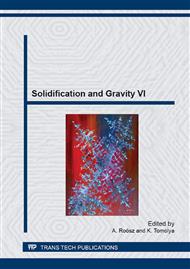[1]
H. Bessemer, U.S. Patent 49053. (1865).
Google Scholar
[2]
M. Ferry, Direct strip casting of metals and alloys – processing, microstructure and properties, Woodhead Publishing, Ltd., Cambridge, (2006).
Google Scholar
[3]
M. Yun, S. Lokyer, J.D. Hunt, Twin roll casting of aluminium alloys, Mater. Sci. Eng. A, A280 (2000) 116-123.
DOI: 10.1016/s0921-5093(99)00676-0
Google Scholar
[4]
C. Gras, M. Meredith, J.D. Hunt, Microdefects formation during the twin-roll casting of Al–Mg–Mn aluminium alloys, J. Mater. Process. Technol., 167 (2005) 62-72.
DOI: 10.1016/j.jmatprotec.2004.09.084
Google Scholar
[5]
R. G. Kamat, AA3104 can-body stock ingot: Characterization and homogenization, JOM, 48(6) (1996) 34-38.
DOI: 10.1007/bf03222964
Google Scholar
[6]
A.L. Greer, Control of grain size in solidification, in: Cantor B, O'Reilly KAQ (Eds. ), Solidification and casting, Institute of Physics Publishing, Bristol and Philadelphia, 2003, p.214.
Google Scholar
[7]
B.S. Murty, S.A. Kori, M. Chakraborty, Grain refinement of aluminium and its alloys by heterogeneous nucleation and alloying, Inter. Mater. Rev. 47 (1) (2002) 3-29.
DOI: 10.1179/095066001225001049
Google Scholar
[8]
Z. Bian, I. Bayandorian, H. Zhang, G.M. Scamans, Z. Fan, Extremely fine and uniform microstructure of magnesium az91d alloy sheets produced by melt conditioned twin roll casting. Mater. Sci. Technol. 25(5) (2009) 599-606.
DOI: 10.1179/174328408x326129
Google Scholar
[9]
S. Kumar, N. Hari Babu, G. M. Scamans, Z. Fan, Microstructural evaluation of melt conditioned twin roll cast Al–Mg alloy, Mater. Sci. Technol. 27(12) (2011) 1833-1839.
DOI: 10.1179/1743284710y.0000000044
Google Scholar
[10]
H. -T. Li, Y. Wang, Z. Fan, Mechanisms of enhanced heterogeneous nucleation during solidification in binary al–mg alloys, Acta. Mater. 60 (2012) 1528-1537.
DOI: 10.1016/j.actamat.2011.11.044
Google Scholar
[11]
R. E. Sanders, Jr. Technology innovation in aluminum products, JOM 53(2) (2001) 21-25.
Google Scholar
[12]
Z. Fan, Y. B Zuo, B. Jiang, UK patent 1015498. 7. (2010).
Google Scholar
[13]
S.A. Lockyer, M. Yun, J.D. Hunt, D.V. Edmonds, Micro- and macrodefects in thin sheet twin-roll cast aluminum alloys, Mater. Char. 37 (1996) 301-310.
DOI: 10.1016/s1044-5803(97)80019-8
Google Scholar
[14]
Y. Wang, H. -T. Li, Z. Fan, Oxidation of aluminium alloy melt and inoculation by oxide particles, Trans. Indian Inst. Met. 65(6) (2012) 653-661.
DOI: 10.1007/s12666-012-0194-x
Google Scholar
[15]
Z. Fan, Y. Wang, M. Xia, S. Arumuganathar, Enhanced heterogeneous nucleation in AZ91D alloy by intensive melt shearing, Acta Mater. 57 (2009) 4891-4901.
DOI: 10.1016/j.actamat.2009.06.052
Google Scholar
[16]
Z. Fan, An epitaxial model for heterogeneous nucleation on potent substrates, Metall. Mater. Trans. A 44 (2013) 1409-1418.
DOI: 10.1007/s11661-012-1495-8
Google Scholar
[17]
I. Maxwell, A. Hellawell, A simple model for grain refinement during solidification, Acta Metall. 23(2) (1975) 229-237.
DOI: 10.1016/0001-6160(75)90188-1
Google Scholar
[18]
M. Easton, D. St. John, Grain refinement of aluminum alloys: Part I. The nucleant and solute paradigms—a review of the literature, Metall. Mater. Trans. A 30 (1999) 1613-1623.
DOI: 10.1007/s11661-999-0098-5
Google Scholar


